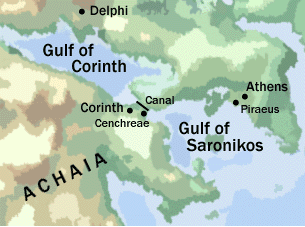Marriage, Divorce, and Singleness
by Jeffrey J. Harrison
With its white marble columns set against Mediterranean blue skies, Corinth sits at a picture-perfect location high above the Greek shoreline. The panoramic view from the city includes the back-to-back Gulfs of Corinth and Saronikos. In Roman times, the narrow strip of land between the gulfs was a crucial transit point. Today there is a deep, rock-cut canal cut between them.* But in Paul’s day, ships were hauled overland on rollers from one side to the other—a distance of 4 miles (6.4 km). This guaranteed some shore leave for the sailors, which they took full advantage of.

* Started but then abandoned by the Emperor Nero in AD 67 with a workforce of Jewish prisoners from the ongoing Jewish Revolt against Rome. The canal was not completed until 1893.
As a result, Corinth, like other port cities of the world, was renowned for its vices: to act like a Corinthian
meant to live a dissolute, immoral life. One of the special attractions of the city was the citadel-like mountain rising behind the city (the Acrocorinth, see photo above). Once serving as an impregnable fortress, it was now better known for its temple to the pagan goddess Aphrodite, with a thousand priestesses that served essentially as prostitutes. No wonder Paul had to talk so frequently to the Corinthians about morality (1 Cor. 5:1-5, 6:13-7:40, 11:5-6).

The first century AD was the peak of prosperity of the Roman Empire: a moment of greatness it would ever after try to recapture. But as often happens in times of prosperity, there was a steep decline in the Empire’s morality and a revolution against traditional ideas about marriage. Originally, Roman marriage brought the wife under the legal authority of her husband, who ruled as the head of the household. But with increasing wealth came increasing independence for women. Women began to appear in roles once in the domain of men: doctors, artists, musicians, atheletes, merchants. Some became quite powerful, even holding government offices. As a result, women were less willing to submit to a man’s authority. This led to a new form of marriage: marriage based on mutual consent, in which the wife remained legally a part of her father’s family, instead of the family of her husband. This made it possible for a woman to divorce her husband, which had been impossible under the older system (Mark 10:12).

Many moderns might assume these developments were good for women. They certainly match the ideals of our own age. But in fact, the overall position of women in the Empire declined. One of the most appalling examples was the practice of exposing female babies—setting them out to die. Parents preferred boys, since girls required a costly dowry at the time of marriage. Sometimes slave traders would rescue the babies to be raised in a life of prostitution. The ease of divorce meant that a woman could suddenly find herself abandoned or replaced, much as in the modern epidemic of single parent households through which many women have been reduced to poverty. Even if a woman remained married, the affections of her husband might be taken by a homosexual relationship, which became fashionable again as it had been in ancient Greece.
In Corinth, the open practice of these modern-sounding vices tormented the apostle Paul. The book of Romans, probably written while he was staying in Corinth, condemns lust and homosexuality among other sins (Romans 1:18-32). In the face of the new morality
that he saw everywhere around him, Paul advocates a traditional, Jewish and Biblical lifestyle, based on a family structure in which the father is the head of the family and has the ultimate responsibility for his wife and children: The husband is the head of [in authority over] a wife
(1 Cor. 11:3).
This traditional view of male authority has been widely rejected in the modern West, in part because of its many abuses. But the relationship Paul describes is quite different than the traditional Roman marriage, in which the husband had an absolute and potentially tyrannical authority over his wife. Rather, Paul compares the headship of the husband to the headship of God the Father over his Son, Jesus: God is the head of the Messiah
(1 Cor. 11:3). Why is this so unexpected and surprising? Because the Christian faith is based on the belief that these two, Father and Son, are together one God (echad in Hebrew, as in Deut. 6:4).* That means that the authority of the Father doesn’t diminish the Son or reduce the Son’s authority or power in any way. Rather through their unity, the authority of the Father actually enhances the authority of the Son, and vice versa. In the same way, the husband and wife are also one: one flesh (also echad, as in Gen. 2:24, and they will be one flesh
). Here, too, the authority of the husband is not intended to diminish, but rather to enhance the wife’s authority, as actually happens in a healthy marriage, and vice versa.**
* Christians understand the plural name for God, Elohim, that appears in Deut. 6:4 and throughout the Bible to be a hint to the inner complexity of God known as the Trinity or Tri-unity of God. Yet this same verse also affirms that God is one (Yhwh echad, the Lord is one
).
** Paul says that a wife is the glory of her husband (1 Cor. 11:7). The better he takes care of her and provides for her, the better it reflects on him as a husband (Eph. 5:28-33). See our translation of Ephesians 5 with notes.
Paul bases his teaching on the Creation account: man was created first, and woman was created for the man’s sake
(1 Cor. 11:8-9, alluding to Gen. 2:18). He along with other Jewish scholars understood that the Bible does not teach a simplistic equality between men and women.* Rather, being male and female are distinct and separate callings. There’s a reason why we are created one or the other. And it’s a reflection of our purpose and destiny.
* Paul retains the essential Biblical and rabbinic asymmetry between man and woman in his discussion of special cases arising out of marriage: a man abandoned by a non-believing wife (1 Cor. 7:15) is permitted to remarry (1 Cor. 7:27-28), as is the man who divorces an adulterous wife. But a woman in the same situation cannot remarry until her spouse dies (1 Cor. 7:11,39). Jesus similarly excluded marriage to a legitimately divorced woman, which according to his understanding could only be an adulterous woman (Matt. 5:32, see below). Roman law also forbid marriage to an adulterous woman, from whom divorce was required, though Roman divorce was also permitted on other grounds. This asymmetry between men and women reflects the permissibility of polygamy in Jewish law and society, though already rare at the time and eventually discontinued (by decree of Rabbi Gershom ben Judah in 1000 AD). But even here, these ideas, which run so counter to modern sensibilities, reflect the nature of God, who as a singular husband can be married to a plural bride (the nation of Israel/the Church), yet we, his bride, can have no other.
Jesus also bases his teaching on marriage on the Creation account (Matt. 19:4-5). The context in which this teaching was given was the ongoing debate between two groups of Pharisees: the followers of Hillel and the followers of Shammai. The followers of Hillel taught that a man can divorce his wife for any reason at all—even if he doesn’t like a meal she prepared, or if he finds a more beautiful woman. This is why they asked: Is it permissible for a man to divorce his wife for any reason?
(Matt. 19:3) They’re asking, in other words, if the followers of Hillel are right or not. Jesus’ appeal to Genesis focuses on the phrase and the two will become one flesh
(Matt. 19:5 quoting Gen. 2:24). His conclusion: What therefore God has joined together, let not man separate
(Matt. 19:6). The union of a man and a woman is an act of God that no human being has the right to end.*
* So long as both are living (Rom. 7:2).
In response, the Pharisees appeal to Deuteronomy 24 and its instructions about divorce: Why then did Moses command to
(Matt. 19:7 quoting Deut. 24:1).* If Moses permitted divorce, how can you, Jesus, forbid it? give her a certificate of divorce and send her away?
Because of your hardness of heart,
Jesus said, it was permitted, but from the beginning it has not been this way.
Here’s another allusion to Genesis as a picture of God’s plan for marriage (Matt. 19:8).
* This certificate of divorce, called a get in Hebrew, was intended to discourage hasty divorce. Since few knew how to read and write in the time of Moses, the services of a scribe were required, which lengthened the procedure and brought it into the public domain. Other obligations have been added over time: the get has to be written by a scribe specifically for that couple, it has to be signed by witnesses, the process must be done before a rabbinical court, the divorcing husband often has to provide his wife with a certain amount of money. By contrast, the procedure among Muslims is simply for the man to say I divorce you
three times.
Then Jesus renders a legal decision (a halakhic ruling): The one who divorces his wife, not because of any unfaithfulness, and marries another commits adultery
(Matt. 19:9). This is a decision about the correct interpretation of Deuteronomy 24:1, the verse that serves as the basis for Mosaic divorce. The grounds given for divorce in that verse are often translated, because he has found some indecency in her.
But in Hebrew, it says literally, because he has found some nakedness of a thing in her.
This was interpreted by Hillel and his followers, including those questioning Jesus, to mean any shameful thing.
This is what led them to rule that a man could divorce his wife for any reason at all, which eventually became the view of normative Judaism.
But Jesus agreed with the opposition—the Jewish rabbi Shammai and others, including the Dead Sea Community—that nakedness of a thing
referred only to unfaithfulness.* Therefore, anyone who puts away his wife for any other reason and marries another commits adultery according to the Law of Moses. This is yet another example of Jesus as a defender of the Jewish Law against the doctrines of men, a major theme of his teaching ministry, and quite unlike the popular view that he was a renegade opposed to the Law.**
* Git. 9:10; the Damascus Document iv.21-v.6.
** Jesus’ ruling also forbids the practice of polygamy. How so? The divorce of a woman that is not unfaithful (the first part of Matt. 19:9) is not in itself adultery, since from the point of view of Jesus and others, this is not a valid divorce, and the two are still married (and can be reunited; see 1 Cor. 7:10-11). Only with the addition of the second phrase in that verse (Matt. 19:9), and marries another,
would the action of an invalid divorce be turned into adultery. But this can only be true if polygamy is forbidden. Otherwise taking another wife in itself would not be considered adultery. This understanding is contested in the variant readings of Matthew 19:9, but not in the parallels in Mark 10:11 and Luke 16:18.
Jesus’ ruling was a shock to his disciples (Matt. 19:10). Divorce for any reason had become common, such that his disciples couldn’t imagine it any other way. But it was a right reserved exclusively to men. Women are not permitted to divorce according to Jewish law even today. And though remarriage is permitted, a divorced woman can have difficulty finding a partner, especially if she is older. By limiting divorce, Jesus effectively equalized the playing field between men and women, a privilege envied by women without such rights in the Middle East today.*
* Muslim women have no such protection under Muslim law. Later rabbis had a tendency to discourage divorce, although the man’s basic right of divorce remains, and is even insisted on by rabbinical law in such sad situations as the disability of the wife (where it affects her ability to cohabit), certain types of disease, or her failure to conceive after ten years.
The disciples responded to Jesus’ ruling, a bit peevishly, by saying that then it would be better not to marry
(Matt. 19:10). Surprisingly, Jesus accepts this statement, and goes on to introduce the idea of remaining single for the kingdom of heaven
(Matt. 19:11-12). He describes this single lifestyle as being a eunuch.
This is a harsh term, implying the neutering of the male member (Deut. 23:1). This makes it similar to his sayings about it being better to cut off hands or feet, or pluck out an eye, than be thrown into the Gehenna of fire
(Matt. 5:29-30, 18:8-9).* Fortunately, he didn’t require this challenging lifestyle for everyone, but only for those who are able to accept it (Matt. 19:12).
* Gehenna was the term used by Jesus and the rabbis for eternal physical punishment, equivalent to the Lake of Fire in the book of Revelation (Rev. 20:14-15).
Jesus’ advocacy of celibacy was a radical teaching, especially in a Judaism that taught, the unmarried person lives without joy, without blessing, and without good
(Yeb. 62b:13). To this day, Jesus’ advocacy of singleness is seen by many religious Jews as so strange and foreign, it puts him ideologically outside of Judaism.*
* Yet it’s another example of Jesus turning the traditional understanding of his day upside down in favor of those who were despised and rejected—in this case the unmarried, the widow, and the childless.
But in his day, Jesus wasn’t alone. The Dead Sea Community living at Qumran also advocated celibacy for its members, also in the context of their expectancy of the coming of the Messianic kingdom. Similarly for Jesus, singleness was associated with the coming earthly reign of the Messiah: Those considered worthy to attain to that age and the resurrection from the dead neither marry nor are given in marriage. For neither are they able to die any more, for they are like angels and are sons of God, being sons of the resurrection
(Luke 20:34-35).*
* Far from teaching that we become angels when we die, as this section is popularly misunderstood, it instead provides a flash of insight into the time of the resurrection of the righteous (those raised out from
the unrighteous dead prior to the general resurrection; cmp. Luke 14:4). The Hebrew idiom here is rich: those considered worthy to attain
is reminiscent of the blessing spoken at Jewish feasts even today: Blessed are you, Lord...who has kept us alive, and preserved us, and enabled us to attain to this season.
Even the simple phrase, that age
(yom ha-hu in Hebrew) was a common designation of the endtimes, evoking a whole series of prophetic pronouncements introduced by this phrase in the Bible. This age of righteousness preceding the general resurrection is commonly known among Christians as the Millennium or Messianic Kingdom (Rev. 20). But unlike much popular teaching on the subject, Jesus says it will be an age in which only those who are found worthy will be included. Fleshly unbelievers and the bearing of children are specifically excluded (Luke 20:34-35).
The approaching end of the age is also Paul’s reason for advocating the single lifestyle:The time is short,
he says, until the coming of the Lord, and the form of this world is passing away
(1 Cor. 7:29,31). Therefore even those who have wives should be as though they had none
(1 Cor. 7:29). The goal, whether married or single, is to be completely focused on the Lord (1 Cor. 7:35), to present a radical and holy witness to his coming return in the midst of a perverse generation.